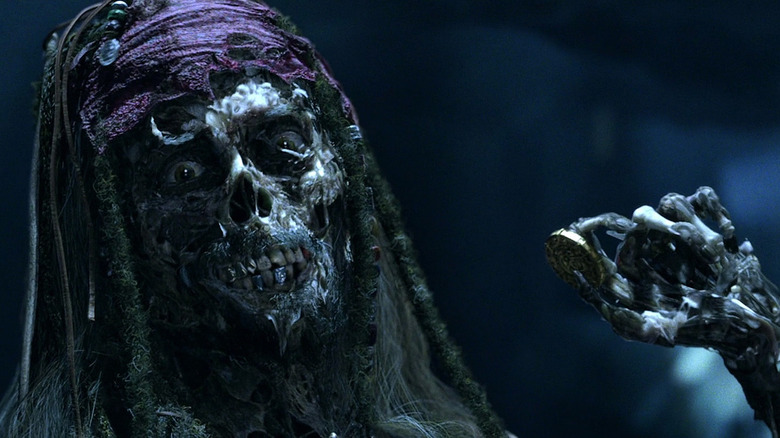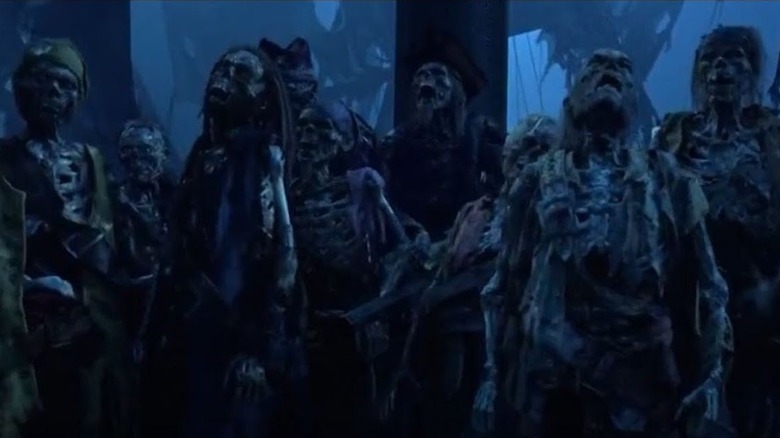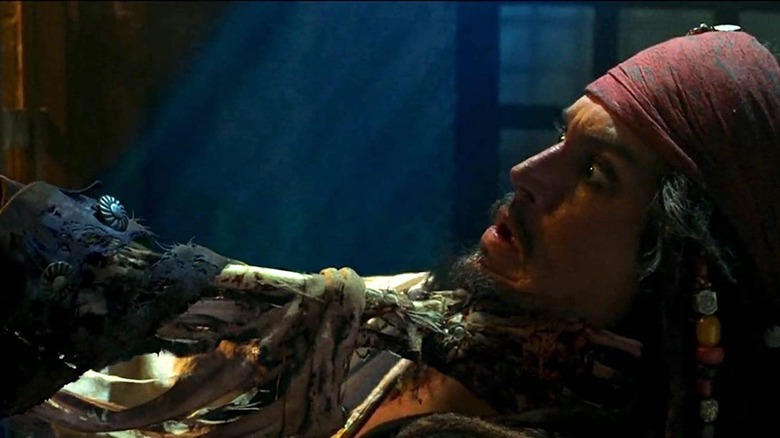How Pirates Of The Caribbean's Meaty Special Effects Brought Its Skeleton Crew To Life
In the harsh light of day, Captain Barbossa's crew in "Pirates of the Caribbean: The Curse of the Black Pearl" looks like any other bunch of sailors. Under the moonlight, though, the cursed pirates become otherworldly beings, shifting into skeletal buccaneers. What's fascinating about watching these bony lads is that they're still recognizable as individuals. You can see the structure of their faces, dreadlocks hanging down from decaying skulls, and distinct beards covering their ossified jaws. That look came courtesy of the film's award-winning special effects team, visual effects supervisor John Knoll and VFX art director Aaron McBride, who wanted the Black Pearl's crew to maintain their discernible features.
In a behind-the-scenes look at the making of "Pirates," (considered one of the best pirate movies ever made) director Gore Verbinski discusses how his team spent time achieving just the right balance of "alive but decomposing" for their pirates. Much of the magic hasn't worn off the "Curse of the Black Pearl" despite it first being released nearly 20 years ago; the movie mixes the actors' real flesh and bone captured on camera with CGI effects. But computerized imagery wasn't the only layer that gave the pirates their sea legs. McBride literally put meat on the bone to create the specific style of each crew member.
"We started by playing around with how much meat to bone ratio we wanted. For instance, this character right here [Pintel, as played by actor Lee Arenberg], we actually took digital photos of turkey jerky and grafted this turkey jerky texture on top of a skull that we had taken a digital photo of as well. And then added little flakes of skin kind of coming off the chin and matted hair to sort of give each one of the pirates their own unique pattern of decay."
Moonlight meat
McBride is a veteran within the visual effects industry and has spent more than two decades in the business. Looking at the end product in "Curse of the Black Pearl," one would assume that he had an integral part of the film. Yet McBride was only working as a concept artist on Ang Lee's "The Hulk" when he was called for a two-day stint that would turn into a full-time role as art director on director Gore Verbinski's swashbuckling movie. It was early on in the project when Disney wanted to a find a unique look for skeletal pirates that inspiration struck McBride, as he recounted to Lucasfilm:
"My brain immediately went to sometime before when my wife had given me this turkey jerky snack to eat. So I asked if I could run to the grocery store and pick some up. I then took photos of it on my desk and collaged them onto the surface of a skull. The director of the film really liked it."
If you delve into McBride's concept art on his Instagram, it's easy to see how the production team of "Pirates" needed his artistic vision. His mythology development for his graphic novel "Toraidhe" is inspired and brings to mind the golden, swooping lines of art nouveau or the work of midcentury concept artist Eyvind Earle. In one instance, we see how McBride's visuals for a scene in 2007's "Pirates of the Caribbean: At World's End" were not only used as concept art but as a digital makeup element. Much like the turkey jerky in the original movie, McBride's tentacle wound illustration in the third film was grafted onto the actor by a special effects artist.
A terrifying task
McBride's role in "Pirates" wasn't the only component of the film's special effects department that the production had grossly underestimated. The creators originally believed they would only need 160 effects shots. Instead, it required more than four times that amount to capture the images necessary for all the ships and skeletons featured throughout the film, according to Knoll. Adding to the already immense challenge of merging the actors' movements with CGI skeletons was that Verbinski wanted to shoot with hand-held cameras, further cornering the effects department.
Marrying the actors and their skeletal counterparts was a terrifying task for animation supervisor Hal Hickel. In an interview with Deseret, Hickel explained that the multistep process of creating the pirates began by photographing actors in wardrobe, creating a skeletal painting of each individual actor, and then building a skeleton based on a 3D scan of the actors. As Hickel's colleagues kept the actors' personalities in tact with bits of jerky, he wanted to preserve their sense of life even when converting them into the undead:
"Geoffrey Rush is a great actor, and you enjoy watching his eyes ... you can't just change to a skeleton without getting that same spark of life behind his eyes."
The pirates in "Curse of the Black Pearl" might be decaying before our very eyes, but that's precisely why they've aged so well over the last two decades. And it sounds like we can thank the talent of great visual effects artists, stunning CGI, and all those preservatives you find in jerky.


